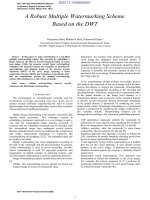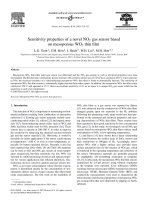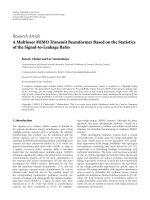adaptive sliding mode control of a pem fuel cell system based on the super twisting algorithm
Bạn đang xem bản rút gọn của tài liệu. Xem và tải ngay bản đầy đủ của tài liệu tại đây (968.23 KB, 13 trang )
<span class="text_page_counter">Trang 1</span><div class="page_container" data-page="1">
HANOI UNIVERSITY OF SCIENCE AND TECHNOLOGY
Project I
ADAPTIVE SLIDING MODE CONTROL OF A PEM FUEL CELL SYSTEM
BASED ON THE SUPER TWISTING ALGORITHM
Control engineering and Automation
Instructing teacher: Dr. Vu Thi Thuy Nga
Department:
Dr. Le Minh Hoang Automation
University: Hanoi University of Science and Technology
HA NOI, 8/2023
</div><span class="text_page_counter">Trang 2</span><div class="page_container" data-page="2">3 Acknowledgement
Through this course and research, we have had the chance to learn the basics of a control system. In addition, we are able to cooperate with friends to work on a new and interesting topic which can contribute greatly to society in the future. With this, we want to express our gratitude towards my instructor, Mrs Vu Thi Thuy Nga, as well as our seniors for helping us along the course.
Abstract
Proton exchange membrane fuel cells (PEMFCs) are the most promising fuel cell technology because of their high-power density, low operating temperature, quick startup capability, and low weight. Efficient use of the PEMFC requires keeping it working at an adequate power point and protecting fuel cells from damage problems. Through this course, we learn how to extract the maximum power from the PEMFC system and protect it from membrane damage by stabilizing the hydrogen and oxygen partial pressure. To this end, a control scheme composed of a maximum power point tracking (MPPT) controller and pressure controller is proposed. The second order sliding mode control (SMC) is used to overcome the chattering phenomenon caused by the conventional SMC.
</div><span class="text_page_counter">Trang 3</span><div class="page_container" data-page="3">4
Contents
I. Introduction ... 5
II. PEM fuel cell system modeling ... 6
2.1. PEM fuel cell ... 6
2.2. System modeling ... 7
III. Control design of the PEM fuel cell system ... 11
3.1. Sliding mode control approach ... 11
3.2. Adaptive sliding mode control based on super-twisting algorithm ... 12
IV. Conclusion ... 13
REFERENCE ... 14
</div><span class="text_page_counter">Trang 4</span><div class="page_container" data-page="4">5 I. Introduction
Fuel cells are one of the environmentally friendly energy sources that generate electricity through an electrochemical reaction. At the moment, there are six main fuel cell types classified according to the electrolyte and fuel used: phosphoric acid fuel cell (PAFC), molten carbonate fuel cell (MCFC), alkaline fuel cell (AFC), solid oxide fuel cell (SOFC), proton exchange membrane fuel cell (PEMFC), and direct methanol fuel cell (DMFC). Among the mentioned types of fuel cell, PEMFC stands out to be the most popular type for mobile and portable applications, due to some advantages such as: heat and water management, a high power density, the reaction of electrode kinetics, alternative catalysts, a low weight, and a low operating temperature. However, PEMFC presents some disadvantages: very high sensitivity to impurities of hydrogen, expensive catalyst and membrane, a gas diffusion layer and flow field layers, degradation, and production difficulties of the membrane electrode assembly. PEMFC consists of a polymer electrolyte membrane placed in the middle of two electrodes called anode and cathode. Hydrogen fuel is fed through the anode and an oxidant (air or pure oxygen) is pumped into the cathode. Hydrogen molecules are split into electrons and hydrogen protons at the anode catalyst. Hydrogen protons migrate toward the cathode through the membrane and react with the returning electrons and oxygen to produce water and heat. Free electrons at the anode will flow to the cathode through an external load and provide electricity.
PEMFC system control has to take into account problems related to harvesting electrical energy from the PEMFC stack. Fuel cells have a nonlinear voltage–current characteristic, and the power has several local maximum power points in the I P –characteristic under various operating conditions. Therefore, an MPPT algorithm must be established to improve and optimize the PEMFC system efficiency. The problem of fuel starvation as a result of sudden load variations can lead to serious membrane damage in the fuel cell. This problem can be avoided by controlling the inlet flow rates of hydrogen and oxygen to stabilize the partial pressures and protect the fuel cell from damage.
To achieve this aim, a robust control scheme based on the second order sliding mode control is elaborated. The control scheme is composed of an MPPT controller and pressure controller. The pressure control was set using the super twisting algorithm, while the MPPT control was carried out using an adaptive sliding mode controller. The effectiveness and the superiority of the ASMC in terms of convergence time and power extraction is proved through a comparison study with conventional SMC and STA.
In this research, however, we are considering the source tank in ideal condition, with the pressure at a constant level.
</div><span class="text_page_counter">Trang 5</span><div class="page_container" data-page="5">6 II. PEM fuel cell system modeling
2.1. PEM fuel cell
The FC output voltage can be described as follows: V<small>cell</small>= E<small>Nernst</small>− η − η <small>actohmic</small>− η <small>con</small>
( 1) 𝐸<small>𝑁𝑒𝑟𝑛𝑠𝑡</small> is the reversible open-circuit voltage, it is described by the Nernst equation as:
𝐸<small>𝑁𝑒𝑟𝑛𝑠𝑡</small>= 1.229− 8.5 ×10<small>−4</small>(𝑇 −298 15). + 4.308 10× <small>−5</small>( 𝑃𝑙𝑛 <small>𝑂2</small>+ 𝑙𝑛𝑃<small>𝐻2</small>) (2) where 𝑃<small>𝐻2</small> is the hydrogen partial pressure (atm), 𝑃<small>𝑂2</small> is the is oxygen partial pressure (atm) and is the absolute temperature (K). T
𝜂 <small>𝑎𝑐𝑡</small> is the activation voltage drop, it is given in the Tafel equation as: 𝜂 <small>𝑎𝑐𝑡</small>=<small>ξ 1</small>+<small>ξ</small><sub>2</sub>𝑇 +<small>ξ</small><sub>3</sub>𝑇𝑙𝑛𝐶<small>𝑂2</small>+<small>ξ</small><sub>4</sub>𝑇𝑙𝑛𝐼<small>𝐹𝐶</small>
(3) where 𝐼<small>𝐹𝐶</small> is the fuel cell current (A), and <small>ξ</small><sub>𝑖</sub>(i=1-4) are parametric coefficients for each cell model. 𝐶<small>𝑂2</small> represents the concentration of dissolved oxygen in the interface of the cathode catalyst which can be calculated as:
𝐶<small>𝑂2</small>= <sup>𝑃</sup><sup>𝑂</sup><small>2</small>
(5.08 10× <small>6</small>)𝑒<sup>−498</sup><sub>𝑇</sub>
(4) 𝜂 <small>𝑜ℎ𝑚𝑖𝑐</small> is the overall ohmic voltage drop, it can be expressed as:
𝜂 <small>𝑜ℎ𝑚𝑖𝑐</small>= 𝐼<small>𝐹𝐶</small>𝑅<small>𝑚</small>
(5) where 𝑅<sub>𝑚</sub> is the ohmic resistance and given by:
(6) where A is the cell active area (cm2), tm is the membrane thickness (cm). 𝑟<small>𝑚</small> is the membrane resistivity cm) to proton conductivity and can be calculated as: (Ω
𝑟<small>𝑚</small>=<sup>181</sup><sup>.6[1 + 0.</sup><sup>03</sup><sup>(</sup>𝐼<small>𝐹𝐶</small>
𝐴) + 0.0062(𝑇/303)<small>2</small>(<sup>𝐼</sup><small>𝐹𝐶</small>
𝐴)<small>2.5</small>][𝜆 <small>𝑚</small>− 0.634− 3(<sup>𝐼</sup><small>𝐹𝐶</small>
(7)
</div><span class="text_page_counter">Trang 6</span><div class="page_container" data-page="6">7 where 𝜆 <small>𝑚</small>represent the membrane water content and it is a function of the average water activity 𝑎 :<small>𝑚</small>
𝜆 <small>𝑚</small>= {<sup>0.</sup><sup>043 17</sup><sup>+</sup> <sup>.</sup><sup>81</sup><sup>𝑎</sup><small>𝑚</small>−<sup>39</sup><sup>.</sup>85𝑎<sub>𝑚</sub><small>2</small>+36<sup>𝑎</sup><sub>𝑚</sub><small>3</small> 𝑖𝑓 0 < 𝑎<sub>𝑚</sub><sup>< 1</sup>14 14+ (𝑎<small>𝑚</small>− 1) 𝑖𝑓 1 < 𝑎<small>𝑚</small>< 3
(8) The average water activity is function of the cathode water vapor partial pressure 𝑃<small>𝑣,𝑐𝑎</small> ,the anode water vapor partial pressure 𝑃<sub>𝑣,𝑎𝑛</sub> and the saturation pressure of water 𝑃<small>𝑠𝑎𝑡</small>. It can be expressed as:
𝑎<small>𝑚</small>=<sup>1</sup><sub>2</sub>(𝑎<small>𝑎𝑛</small>+ 𝑎<sub>𝑐𝑎</sub>) =<sup>1</sup>2
𝑃<small>𝑣,𝑎𝑛</small>+ 𝑃<sub>𝑣,𝑐𝑎</sub>𝑃<small>𝑠𝑎𝑡</small>
(9) 𝑃<small>𝑠𝑎𝑡</small> can be obtained using the following empirical expression:
𝑙𝑜𝑔<small>10</small>𝑃<small>𝑠𝑎𝑡</small>= −2.1794 + 0.02953T − 9.1813 × 10<small>−5</small>𝑇<sup>2</sup> + 1.4454 × 10 𝑇<small>−73</small>
(10) η <small>con</small>is the concentration voltage drop, it is expressed as:
η <small>con</small>= −<sup>𝑅𝑇</sup>
𝑛𝐹ln (1 −<sup>𝐼</sup><small>𝐹𝐶</small>
𝑖<small>𝐿</small>𝐴)
(11) where F is the Faraday’s constant, n is the number of electrons participating in the reaction, is the limiting current and is the universal gas constant. 𝑖<small>𝐿</small> R
The output voltage of a fuel cell stack constitutes by 𝑁<sub>𝐹𝐶</sub> fuel cells connected in series is given by:
𝑉<small>𝑠𝑡</small>= 𝑁<sub>𝐹𝐶</sub>𝑉<small>𝑐𝑒𝑙𝑙</small>
(12) 2.2. System modeling
The PEM fuel cell system adopted in this study is shown in Fig. 1.
Figure 1. The proposed system configuration
</div><span class="text_page_counter">Trang 7</span><div class="page_container" data-page="7">8 It is constituted by an FC stack, a DC/DC boost converter, and a resistive load. The boost converter is used to increase the system’s efficiency by controlling the fuel cell system’s operation point through adjusting the duty cycle of the converter. The specification details of the PEM fuel cell system is given in Table 1.
𝐿(𝑢 − 1) +<sup>𝑉</sup><small>𝑠𝑡</small>
𝐿𝑉 <small>𝑂</small>=<sup>𝐼</sup><sup>𝐿</sup>
𝐶(1 − 𝑢) −<sup>𝑉</sup><small>𝑂</small>
(13) where 𝐼<sub>𝐿</sub> and 𝑉<sub>𝑜</sub> are the inductor current and the voltage at the output terminals of the boost converter, is the duty ratio. It is assumed that u 𝐼<small>𝐿</small> is equal to 𝐼<small>𝐹𝐶</small>.
Eq. (13) can be written as:
𝑥 = 𝐹 𝑥, 𝑡 + 𝐺(𝑥, 𝑡)𝑢(𝑡)( )
(14)
</div><span class="text_page_counter">Trang 8</span><div class="page_container" data-page="8">9 𝑤ℎ𝑒𝑟𝑒
𝑥 = [𝐼<small>𝐿</small> 𝑉<small>𝑜</small>]𝐹(𝑥, 𝑡) = [<sup>𝑉</sup><sup>𝑠𝑡</sup>− 𝑉<sub>𝑜</sub>
𝐿 <sup>𝐼</sup><sup>𝐿</sup>𝐶−<sup>𝑉</sup><sup>𝑂</sup>
𝑅𝐶]<small>𝑇</small>= [𝐹<sub>1</sub> 𝐹<sub>2</sub>]<small>𝑇</small>
𝐺(𝑥, 𝑡) = [<sup>𝑉</sup><sup>𝑂</sup>𝐿 −<sup>𝐼</sup><small>𝐿</small>
𝐶]<small>𝑇</small>= [𝐺<small>1</small> 𝐺<small>2</small>]<small>𝑇</small>
(15) The fuel cell output power depends on the load and the operating conditions like air pressure, oxygen partial pressure, cell temperature, and membrane water content. Using MATLAB simulation with various values of temperature and membrane water content (Resistive load, oxygen partial pressure, and hydrogen partial pressure are regulated respectively to 50 , 2 atm, and 2 atm.), we obtain the power-current Ωcharacteristics of the fuel cell system in fig. 3:
Figure 2. Fuel cell modeling
Figure 3. Fuel cell characteristics for various values of temperature and membrane water content
</div><span class="text_page_counter">Trang 9</span><div class="page_container" data-page="9">10 These curves show the nonlinear characteristic of the fuel cell system, and the power has several local maximum power points (MPP) in the P I characteristic under –variation of cell temperature and membrane water content. Thereby MPP tracking should be used to track its changes.
</div><span class="text_page_counter">Trang 10</span><div class="page_container" data-page="10">11 III. Control design of the PEM fuel cell system
3.1. Sliding mode control approach
Sliding mode control is a nonlinear control method characterized by a suite of feedback control laws and a high frequency switching control action. It forces the system trajectories to reach a given manifold called sliding surface and remains on it after that. When the system state is maintained on this surface, the system is in sliding mode. Its dynamic is then insensitive to system parameter variations and external disturbances as long as the sliding mode conditions are assured.
The design of the control requires mainly three steps: - Choosing the sliding surface.
- Guarantying the reaching conditions. It is given by the following inequality: s(x)𝑠 (𝑥) < 0
- Designing the control law.
In the proposed control law, the switching control leads to high-frequency oscillations on the system outputs known as the chattering phenomenon, degrading the sliding mode control performance. Several approaches have been considered in the literature to reduce or avoid chattering phenomenon, among them:
- Replacement of the discontinuous control by a saturation action. The control law became:
𝑢 =<sup>𝑉</sup><sup>𝑂</sup>− 𝑉<sub>𝑠𝑡</sub>𝑉<small>𝑂</small>
+ 𝑘|𝑠|<small>𝜎</small>𝑠𝑎𝑡(𝑠)
(16) 𝑠𝑎𝑡(𝑠) = {
𝑠𝜀 𝑖𝑓 |𝑠| ≤ 𝜀𝑠𝑔𝑛(𝑠) 𝑖𝑓 |𝑠|> 𝜀
(17)
</div><span class="text_page_counter">Trang 11</span><div class="page_container" data-page="11">12 3.2. Adaptive sliding mode control based on super-twisting algorithm
The aim of the adaptive sliding mode control is to design a suitable control law for the fuel cell stack system under external disturbances and model uncertainties. The control law is a combination between an equivalent control and switching control. The equivalent control forces the system to reach the sliding surface. It has been designed previously in sub-section a. The switching control forces the system’s dynamics onto the sliding surface, weakens the chattering, and achieves robustness to external disturbances and model uncertainties. It is designed based on the super twisting algorithm.
This control law combines the advantages of the STA with the conventional SMC. The following equation gives it:
𝑢(𝑡) = 𝑢<small>𝑒𝑞</small>+ 𝑢<small>𝑠𝑤</small>
(18)
𝑢<small>𝑠𝑤</small>= −𝑘<small>1</small>|𝑠|<small>0.5</small>𝑠𝑔𝑛(𝑠) − ∫ 𝑘<small>2</small>𝑠𝑔𝑛(𝑠)𝑑𝑡
(19)
</div><span class="text_page_counter">Trang 12</span><div class="page_container" data-page="12">13 IV. Conclusion
Following our comprehensive research efforts, we have achieved milestones in the development of a fuel cell model capable of accurately simulating its performance across a wide range of temperatures and membrane water content levels. This model serves as a valuable tool in gaining a deep understanding of the intricate interplay between various parameters and the fuel cell's behavior. Additionally, our team has made significant strides in implementing a system within MATLAB Simulink. While this represents a remarkable accomplishment, we acknowledge that there is still room for improvement to fine-tune its operation for optimal performance.
</div><span class="text_page_counter">Trang 13</span><div class="page_container" data-page="13">14
REFEFEFERERERENCNCNCEEE
[1] Ahmed Souissi, Energy Reports, Adaptive sliding mode control of a PEM fuel cell system based on the super twisting algorithm, 2021.
</div>








